Resources
Fresh perspectives on reducing work friction and improving employee experiences. Research, case studies, and insights on how FOUNT helps transform workflows.
.webp)
.webp)

Beyond Best Practices: Designing for Seamless Integration in Digital Transformations
Guest Post by Isabella Kosch
Isabella Kosch is a customer experience executive and in her past role was the Head of GBS Service Management at Swarovski. With over 20 years of diverse management experience in marketing, product management, service management, transformation, and strategic planning across different industries, she has a proven track record of creating top-notch customer-centric experiences. A former member of ServiceNow’s Product Advisory Council, she has successfully led complex change management programs, aligning technology with a human-centric approach.
How many times have you heard, “We don’t need to design anything – the tech we’re implementing is built on industry best practices”? Sure, off-the-shelf solutions can be implemented quickly, keeping costs down and disruption minimal. When I introduced ServiceNow at Swarovski, we took the same approach: we used the out-of-the-box setup aligned with industry standards to keep things simple. But here’s the thing – best practices are a starting point, not the solution.
While best practices offer a framework, they often overlook a critical factor: how technology integrates into the broader ecosystem. In my experience, the challenge isn’t usually the software’s usability – it’s whether it fits seamlessly with existing workflows and, more importantly, the entire user journey. A process can look perfect on paper, but if it doesn’t interact smoothly with everything else, you’re going to hit roadblocks. These invisible roadblocks can derail even the most well-intentioned transformation.
The Limits of Best Practices
Best practices give you a proven framework and save you from reinventing the wheel. But what if they don’t align with your organization’s needs or culture? During our ServiceNow rollout, the assumption was that industry’s “best” would work as-is. But here’s the reality: even the best software can cause frustration if implemented in isolation. The gaps between the new technology and existing systems often aren’t visible until you’re deep into the implementation.
Service Design: The Missing Link
This is where service design comes in. For too long, organizations have focused on individual processes, often neglecting how these processes fit into the bigger picture. Service design forces a wider view, ensuring that every piece of the user journey works together. Without this, you’re just building great processes in silos that look great on their own, but don’t mesh with the real world of daily work.
I’ve seen this happen teams introduce flawless new processes, but employees still struggle because the systems don’t integrate well, and the user experience is fragmented. Designing for seamless integration is just as essential as the process itself.
Gaining Visibility Across the User Journey
Let’s talk about visibility. Too often, organizations design transactional workflows without considering how they affect the entire journey. What happens outside those formal workflows is just as important as what happens inside.
Informal, 1:1 interactions with customers or employees fall outside formal processes but are just as crucial. These moments shape perceptions and, ultimately, satisfaction. Unfortunately, they’re often invisible because they aren’t measured.
To drive meaningful change, you need to measure what happens outside the structured workflows. Traditional KPIs won’t capture these informal and often hidden interactions, yet they’re key to understanding how well a transformation is performing or an end-to-end process is working.
Beyond KPIs: Measuring What Matters
How do you track what happens outside structured processes? It’s not always straightforward. Traditional metrics measure transactional efficiency, but overlook the unstructured, impactful moments. Those 1:1 interactions I mentioned earlier? They’re often informal, harder to track, but incredibly impactful.
One way to uncover insights that dashboards miss, is through focus groups and interviews. Yes, they take time, and no, they’re not always scalable – but they offer insights that you can’t get from any dashboard. These methods let you dig into the nuances of the user experience, giving you the qualitative data needed to understand where friction points are lurking.
Designing for Flexibility and Scalability
The real challenge comes when you need to scale these insights. Service design, paired with a flexible approach to technology, allows for customization without unnecessary complexity.
A unified entry point, such as an employee portal, can streamline experiences and eliminate fragmentation. Consistency across the enterprise speeds adoption and reduces frustration.
Conclusion
Digital transformation isn’t about deploying technology- it’s about designing systems that empower people and fuel long-term success. Industry best practices provide a solid foundation, but they are not enough. To truly unlock the potential of any transformation, leaders must move beyond the template and focus on how every element connects – across processes, technology, and, most importantly, the human experience.
When service design is prioritized, the result isn’t just a well-functioning system – it’s a future-ready organization. The true test of success is not how seamlessly a system functions in isolation, but how effortlessly it integrates into the real world, driving engagement, productivity, and satisfaction at every touchpoint.
The next time someone tells you best practices are enough, ask them: “Is it enough for today, or are we designing for tomorrow?”
Follow Isabella Kosch on LinkedIn
__________________________________________________________
FOUNT helps organizations going through transformation identify hidden friction points, enabling them to create seamless, human-centered experiences that drive adoption and accelerate transformation outcomes.
We’d be happy to present a tailored business case for your organization to demonstrate how these insights can deliver measurable results.

March Newsletter: Don’t Use Old Methods to Measure A New Way of Working
AI isn’t just about deploying new technology – it’s about fundamentally changing how work gets done. But that change doesn’t happen all at once. It unfolds in daily tasks, team interactions, and the moments that make-or-break productivity.
That’s where work friction comes in.
Just as an AI transformation signals a new way of working, work friction represents a new way of measuring work. And in doing so, it serves as a way for leaders to get out ahead of any employee-related issues or problems that might derail their AI project.
Measuring work friction provides insight into whether an AI tool has had a positive impact on how employees are working, allowing you to validate an AI investment very early in the rollout. By looking specifically at employees’ task-by-task experiences and isolating the moments in their work days that slow them down or cause them trouble, you can get a clear picture of how AI is impacting those moments.
The beauty of assessing work friction is its precision. You no longer need to guess if your technology is effective. Instead, you have data-driven proof points to guide decisions, adjustments, and validate early-stage investments.

FEATURED USE CASE
Reduce Product Waste by Reconfiguring an AI Tool
One large retail company was exceeding its product waste targets by upwards of $10 million, but they’d already made all the obvious changes to reduce waste. To reach their targets, they’d have to find and eliminate hidden causes. Through a work friction analysis, input from sales managers revealed the AI-driven ordering system frequently caused overstocking, resulting in expired products and strained customer relationships.
By refining the AI algorithm – adding considerations for seasonality, promotions, and allowing manual adjustments – the company expecting to reduce waste by 20 percent by Q4.
More examples of FOUNT use cases here: How Customers Use FOUNT: Accelerate AI Adoption, Reduce Waste, and Measure ROI Sooner – FOUNT
THE MOST RECENT BLOG POSTS
How AI Tools Change Your Team’s Work (And What to Do About It)
- When you automate work with AI, you change the nature of the remaining work.
- To assess how an AI tool has impacted employees’ work, look for work friction – i.e., high-impact work tasks with low satisfaction scores.
- Address areas of high work friction to ensure positive ROI on your AI investment.
📖 Read it here
AI Transformation Playbook: The Definitive Guide to Measuring, Rescuing, Prioritizing, and Scaling AI Transformations
In this playbook, we’ll lay out everything you need to know to measure the effectiveness of the AI implementations so leaders can: rescue failing tools, prioritize future projects, and scale successful investments.
📖 Read it here
Worker Impact Is the Common Denominator of Every AI Transformation – And the Best Early Indicator of Success
As AI investments surge, organizations are under pressure to prove ROI faster. Yet, traditional methods fall short in showing early results. This blog explains why the best early indicator of AI success is its impact on employee work – specifically, by measuring work friction.
By classifying AI tools based on the type of work they affect – highly defined, open-ended, or enterprise services – leaders can tailor their measurement strategy. Work friction data, gathered through targeted surveys, reveals where AI is helping or hindering daily tasks, offering fast, actionable insight long before financial metrics show results. Bottom line: only employees can tell you if AI is working.
📖Read it here
ARTICLES WE RECOMMEND
📖 Employees Give Feedback, But Leaders Too Stressed At Work To Act On It.
By Dr. Diane Hamilton, a business behavioral expert, for Forbes
Dr. Hamilton highlights a troubling cycle: employees regularly share feedback but disengage when their efforts go unacknowledged due to overwhelmed leaders. Breaking this cycle requires intentional communication, targeted action, and shared accountability to transform feedback into tangible improvements.
📖 Superagency in the workplace: Empowering people to unlock AI’s full potential
By Hannah Mayer, Lareina Yee, Michael Chui, and Roger Roberts for McKinsey & Company
McKinsey’s 2025 report, “Superagency in the Workplace,” underscores a significant disconnect between employee readiness for AI adoption and leadership perception. While 92% of companies plan to increase AI investments over the next three years, only 1% consider their AI deployments mature.
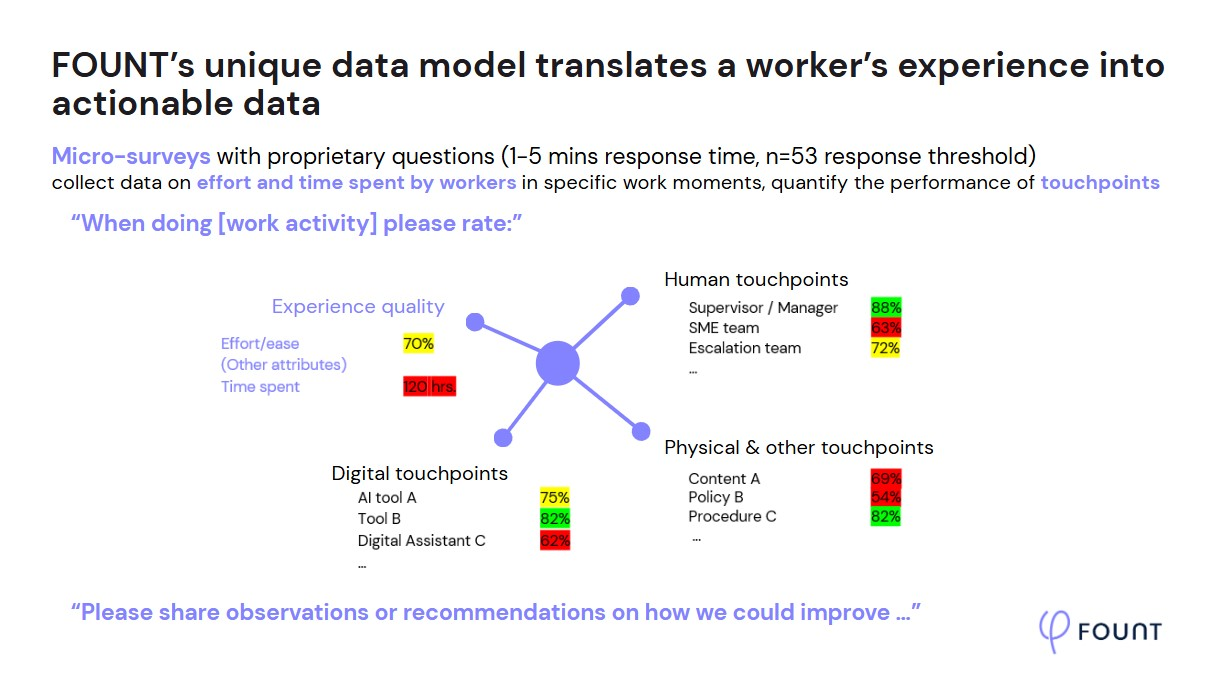
AI isn’t simply about tech – it’s about people and the work they do every day. That’s why measuring work friction matters. It gives leaders early, actionable insight into whether AI tools are actually improving the experience of work – not just in theory, but in the tasks and interactions that make up the workday.
The payoff? Faster course correction, better adoption, and a clearer line of sight into whether your AI investments are delivering value for both the business and your people.
In a transformation where every step counts, understanding work friction isn’t just a nice-to-have – it’s how you stay on course.
Until next time,
The FOUNT Global Team
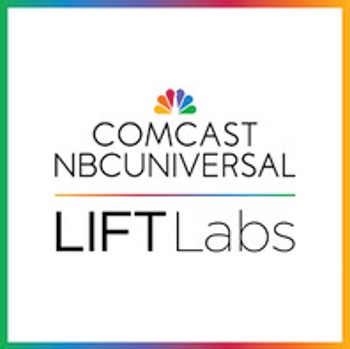
How FOUNT Helps Companies Maximize AI Productivity
originally published by Comcast NBCUniversal LIFT Labs
As companies look to increase workplace efficiencies, many are turning to artificial intelligence to streamline workflows and achieve measurable results. In fact, 75% of general knowledge workers now use AI, with nearly half adopting it within the past six months. But 77% of employees using AI say it increases their workloads and nearly half don’t know how to achieve the productivity gains.
While pressure mounts to show ROI from AI investments, organizations may inadvertently add friction to employees’ existing workflows and potentially impact productivity.. Addressing these barriers is important for companies aiming to balance technological innovation with employee well-being.
FOUNT: Identifying and Eliminating Friction
FOUNT Global, Inc. is a startup that identifies workplace inefficiencies and helps organizations boost productivity and drive business transformations using focused micro surveys that show exactly where to intervene to maximize AI productivity gains. While traditional employee surveys ask about job satisfaction and if they have the right tools to do their jobs, FOUNT surveys pinpoint the root causes of friction, measures their impact, and prioritizes actionable solutions. Their technology evaluates key workflow elements, including time spent on tasks, the efficacy of tools, and the interplay between human and digital touchpoints.
According to FOUNT, companies that use their services tend to reduce costs, improve employee retention, and increase Employee Net Promoter Scores (eNPS)—a key indicator of workplace satisfaction. Crucially, FOUNT also evaluates the success of AI implementations so companies can determine the ROI of their investment.
“We help determine if these tools are actually working and identify areas for improvement.” — Christophe Martel, Co-Founder & CEO FOUNT
The idea for FOUNT was born from Martel’s personal frustrations while managing a 150-person team. Despite his best efforts, he lacked the data needed to understand employee pain points. The problem persisted even when he transitioned to a Chief HR Officer role, where he realized the broader, industry-wide nature of work friction.
“It just doesn’t make any sense,” said Martel. “Companies have transformed customer experiences. Shopping is simple. Returns are simple. Why can’t working at a company be as seamless as shopping online?”
To tackle the problem, Martel teamed up with co-founder Volker Jacobs to build a SaaS platform that identifies and resolves these challenges. The solution quickly gained traction, with FOUNT raising $10.75 million in venture capital funding and landing major Fortune 100 customers. One FOUNT client, a healthcare provider, faced 30% employee attrition rates among new call center employees. By addressing friction points with FOUNT, the company saved $13.4 million by curbing the workplace turnover.
In the fall of 2024, FOUNT joined the AI accelerator program at Comcast NBCUniversal LIFT Labs. The program connected FOUNT with Comcast NBCUniversal executives, opening doors to potential partnerships and valuable feedback. Martel said,
“The accelerator has been invaluable. We’ve gained insights on everything from pricing to refining our value proposition. It’s helping us level up and demonstrate our impact to large enterprises.”
Looking Ahead: A Frictionless Future
FOUNT envisions a future where its data-driven insights influence every aspect of the workday. By providing continuous improvement loops, the company aims to help organizations create environments where employees can thrive.
“For us,” Martel emphasized, “our mission is clear: make it easier for employees to do their best work, every single day.”
Stay connected to Comcast NBCUniversal LIFT Labs, sign up for our newsletter and follow us on LinkedIn.
For anyone curious, here’s our latest case study showing how FOUNT helped reduce friction for developers using AI tools – and revealed exactly where adoption was stalling: https://getfount.com/resource/case-study-leveraging-genai-tools-developers/


What to Do When Employees Resist AI Tools
KEY TAKEAWAYS
- AI leaders outperform laggards, but people and processes often get in the way of AI adoption.
- Employee acceptance of AI is essential to seeing positive ROI.
- To drive employee acceptance, look for work tasks with high impact but low satisfaction. Fix them by making them better for workers.
- To address fears of job loss, open lines of communication and remember that AI changes the nature of work your employees will do.
A lot of media reports on AI focus on the technology itself: what it is, what it can do, etc. But when it comes to getting business value from AI, business leaders agree that the biggest challenges lie not in technical implementation but in people and processes.
In fact, per new BCG research, 48 percent noted that employee resistance – and even fear – of AI tools was a major hurdle preventing them from a positive ROI.
But AI remains a top priority for many firms – as it should. Recent research from BCG shows that the leaders in AI adoption enjoy 50 percent higher revenue, 60 percent higher shareholder returns, 40 percent greater return on invested capital, and even higher levels of employee satisfaction than laggards.
So how can you overcome employee resistance to new AI tools? The key is to monitor the tool’s impact and potential resistance points, then address them as they come up. In this piece, we’ll explain how to do that.
Background: Why Employee Acceptance Matters in AI Transformations
Before we dive into how to get employees to embrace AI tools, it’s worth reiterating why that’s worth doing. AI, as we’ve noted before, is not like other digital transformations. Because AI is a bottom-up technology, it requires user acceptance to make an impact.
In other words: it doesn’t matter how powerful the tool in question is. If your employees don’t use it, it won’t improve your bottom line.
That’s a problem for innovation leads and others championing AI internally: fully half of CFOs will cut funding for an AI project if it doesn’t have a positive ROI within a year.
So getting employees on board matters. A lot.
To do that, leaders first have to understand the two most common reasons employees resist AI:
- The AI tool doesn’t help them do their work.
- They’re afraid the AI will cause them to lose their job.
Let’s take a look at how to address both.
How to Boost Employee Acceptance by Ensuring AI Is Helping, Not Hurting
Let’s zoom out for a minute. The promise of AI tools is to automate specific tasks so that humans no longer have to do them. The result of adopting an AI tool, then, should be an increase in productivity.
Where this goes wrong in practice is in the failure to recognize the larger context AI tools exist within. For example, many organizations approach AI investments from the top down: the biz dev team is an important one to the bottom line, so we’ll find an AI tool with biz dev applications.
This approach is totally backwards for a bottom-up transformation. Why? Because if the AI tool in question doesn’t address an area where the biz dev team is experiencing work friction (aka hurdles to getting work done created by people, processes, or technology), they won’t use it.
Worse, if the tool doesn’t sync well with the other software the team is using, they may simply find workarounds so they can keep doing their work.
So what’s the solution?
If you’ve already adopted an AI tool…
- Survey workers about how the tool impacts specific tasks they complete during their days (e.g., adding a lead to the pipeline, following up on a lead, scheduling a meeting, etc.).
- Create a prioritization matrix, plotting each task by its impact and employee satisfaction with it.
- Look for areas with high impact and low satisfaction: those are your problem areas. Troubleshoot them (e.g. by reconfiguring the AI tool), and you’ll solve your AI acceptance problem.
If you haven’t yet adopted an AI tool…
- Perform the same task as above.
- When you’ve identified problem areas, look for ways to solve those problems.
- Note that, in some cases, the solution might lie within a tool you already have, meaning your AI investment dollars can be better used elsewhere (for a different team or different task).
What to Do When Employees Are Scared for Their Jobs
Now let’s address the elephant in the room. When we talk about increasing productivity, it’s possible to interpret that as doing the same amount of work with fewer human workers.
Whatever your plans for AI, communication is key.
One thing that’s important to keep in mind is that AI tools at this point are largely experimental. That is, most organizations don’t yet know what the outcome of adopting AI will be.
When they’re most successful, AI tools will not only improve productivity; they’ll also change the nature of employees’ work. Take a call center, for example: if AI agents become the norm for handling the simple calls that come in, the work that call center employees do will be more complex and nuanced. It will require different training and different resources.
This is something that’s happened throughout history as new technologies emerged: think of telephone operators. The telecommunications industry barely employs any human operators today, but it’s still an enormous industry with many jobs that didn’t exist 100 or even 50 years ago.
And then there’s another consideration: about half of employees today report being on an overwhelmed team. For many organizations, adding AI won’t make human workers any less necessary, it will simply let them get their jobs done in a way that’s simply not possible without AI resources.
Overcome Employee Resistance to Drive Positive ROI on AI Investments
Employees resist AI when it doesn’t help them complete their work and when they fear it will replace them entirely. That hurts the entire organization’s ability to reap the benefits of this transformational technology.
Organizations that reframe their assessment of AI to its impact on individual employee tasks will be the most successful in both driving employee acceptance and enjoying a positive ROI. As they find more and more compelling AI applications, these organizations will free up resources they can dedicate to new initiatives, positioning themselves to outcompete their competitors.
If you’d like support overcoming employee resistance to AI initiatives, don’t hesitate to get in touch.
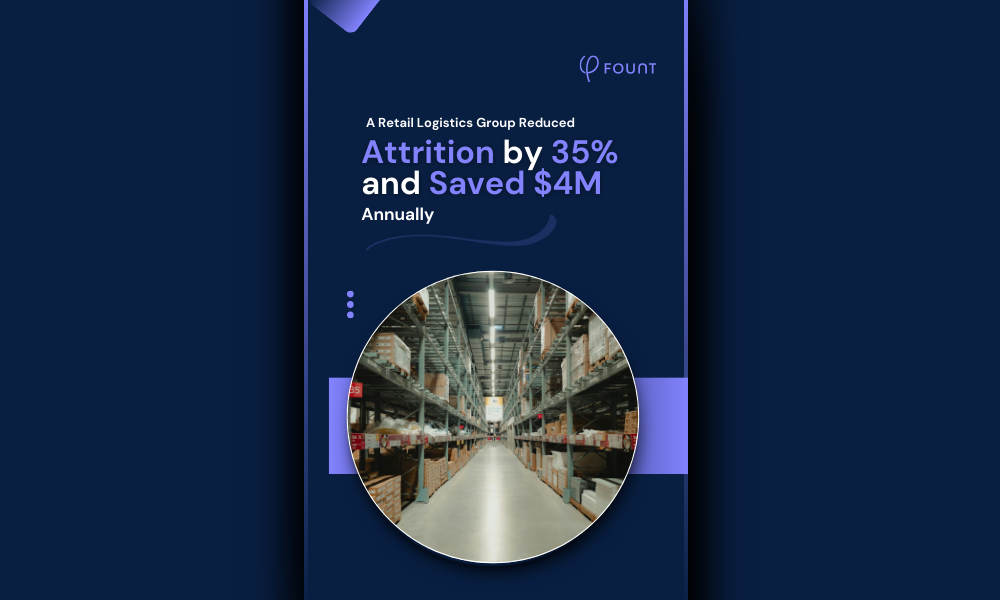
Case Study: $4M in Annual Savings Achieved by Reducing Attrition by 35%
The Challenge
A national retail logistics group faced an alarming 110% attrition rate among first-year employees, particularly affecting 800 order selectors critical to warehouse operations. This led to:
- Increased waste and error rates.
- Higher overtime and onboarding costs.
- Lost revenue and capacity exceeding $5 million annually.
Despite efforts such as pay raises, enhanced benefits, and better training, traditional solutions failed to address the root causes of employee dissatisfaction and turnover.
The Solution
Partnering with FOUNT, the organization identified and addressed key sources of work friction impacting employee retention:
- Pinpointing Friction Moments:
- Key activities analyzed included navigating the warehouse, learning job tasks, discussing pay, coordinating shift plans, and taking breaks.
- Touchpoints such as supervisor interactions and tool usage (e.g., pallet jacks) were examined for inefficiencies.
- Data-Driven Interventions:
- Improved Communication Strategy: Weekly video updates and shift coaches for new hires reduced misunderstandings and improved support.
- Enhanced Training: A 12-week, app-guided onboarding journey was introduced, ensuring consistency and empowering senior employees to mentor new hires.
- Reorganized Warehouse Layout: Simplified navigation through re-slotting improved productivity and reduced confusion for new hires.
- Staffing Adjustments: Increased headcount eased workloads and improved work-life balance for employees, fostering collaboration and reducing burnout.
The Results
After just four months, these targeted actions led to:
- 35% Reduction in Attrition: Average tenure for order selectors increased by eight months.
- $4M Annual Savings: Cost reductions stemmed from improved retention and operational efficiencies.
- 20% Productivity Increase in Year 1: Enhanced workflows and satisfaction boosted overall performance.
- Improved Work Environment: Balanced workloads and better communication created a more sustainable and engaged workforce.
Download the Case Study
Fill out the form below to explore how this retail logistics group transformed operations, reduced attrition, and saved $4M annually with actionable insights from FOUNT.

Measure What Matters: Building a Common Data Model and Governing Structure to assess the impact of AI and Digital Transformation
by Andrei Airimitoaie, Head of Product at FOUNT Global
KEY TAKEAWAYS
- What ultimately matters in a successful deployment of an AI project is its impact on people’s productivity.
- To measure productivity, look at a combination of leading indicators, including satisfaction, effort and time spent on tasks (before and after the introduction of an AI tool).
- When leading indicators are negative, dig into people’s feedback for ideas on how to address high-friction areas.
- Rinse and repeat until your AI project is ROI positive.
Despite AI’s continued dominance in business headlines, only four percent of organizations are currently driving “substantial” value from the technology. Even more telling: less than a quarter have moved past the proof-of-concept stage to drive any value at all.
So what are these leading companies doing differently from everyone else? For one thing, they’re setting ambitious, concrete targets for how AI will improve their business operations. That means they have a system for measuring the impact AI investments are having on their bottom line.
In this piece, we will explain how you can create this system. Read on for an overview of how to measure the impact of an AI tool and how to adjust course to ensure your AI investments stay ROI positive.
What Matters to an AI Project?
The problem is that most organizations don’t have any systems in place for measuring productivity. They may have data on employee sentiment, usage and survey data on their tools, but neither of those methods give an accurate or full picture of productivity. Furthermore, most organizations lack a common data model and governance structure to assess productivity and AI user adoption across the board.
The main reason behind this is because the existing methods are missing the user’s workflow perspective. Put simply, how is this new tool helping me get this particular job done?
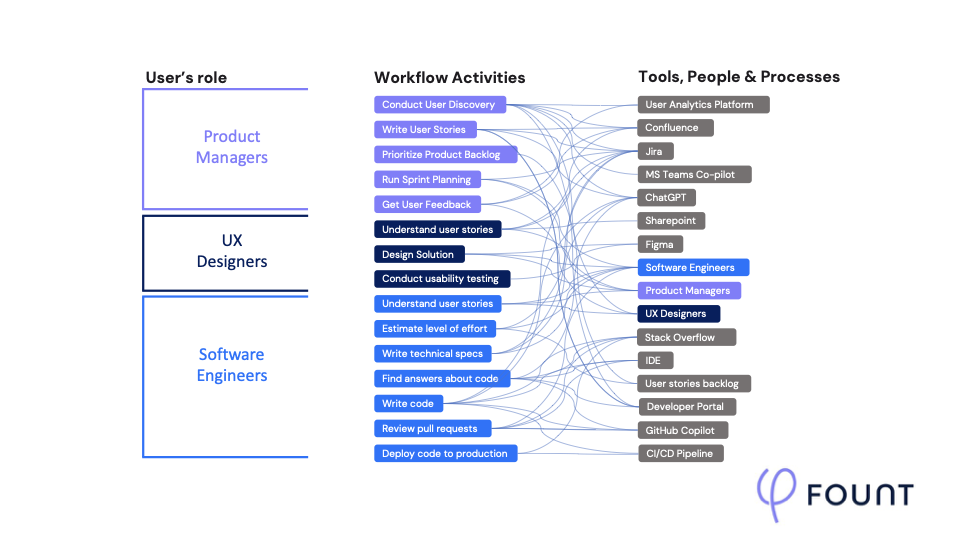
This is where FOUNT’s approach comes in. With a data model that can be applied across roles or business areas, our system quantifies the performance of AI tools across workflow activities.
How to Measure an AI Tool’s Impact on Productivity
To assess an AI tool’s impact on productivity, we look at where work friction crops up in specific work moments the tool affects. What are “work moments”? They’re specific activities or jobs to be done that workers carry out throughout their day.
To get a clearer picture, let’s dive into an example. A financial services organization introduces an AI tool to its software developer team to increase their productivity. To assess this, our platform will send targeted micro-surveys to a subset of the development team, which assess work moments such as:
- Trying to find an answer in the codebase.
- Debugging code.
- Opening a pull request.
- Reviewing a pull request.
- Writing technical documentation.
For each of these moments/activities, we’ll ask questions such as:
- How is your experience with <moment>?
- When was the last time you had to perform <moment>?
- How long do you estimate it took you to perform <moment> the last time?
- To what extent do you agree with the following: The way we do this minimizes unnecessary time waste.
These surveys are sent from our platform or distributed via existing survey tools and take as little as 2-3 minutes to complete.
Once the results are in, we plot work moments on a prioritization matrix (Figure 1).

In the upper-left quadrant are moments that have a high impact on productivity but low satisfaction scores. These are your main problem areas. Start here first to get the biggest bang for your buck on your AI initiatives. You can also use this matrix to identify areas that could benefit from future AI investment.
Next, for each high friction/high impact work moment, look for how much time people spent on this activity, as well as the tools, processes or people that either enable this activity or cause friction. We call these touchpoints (Figure 2).
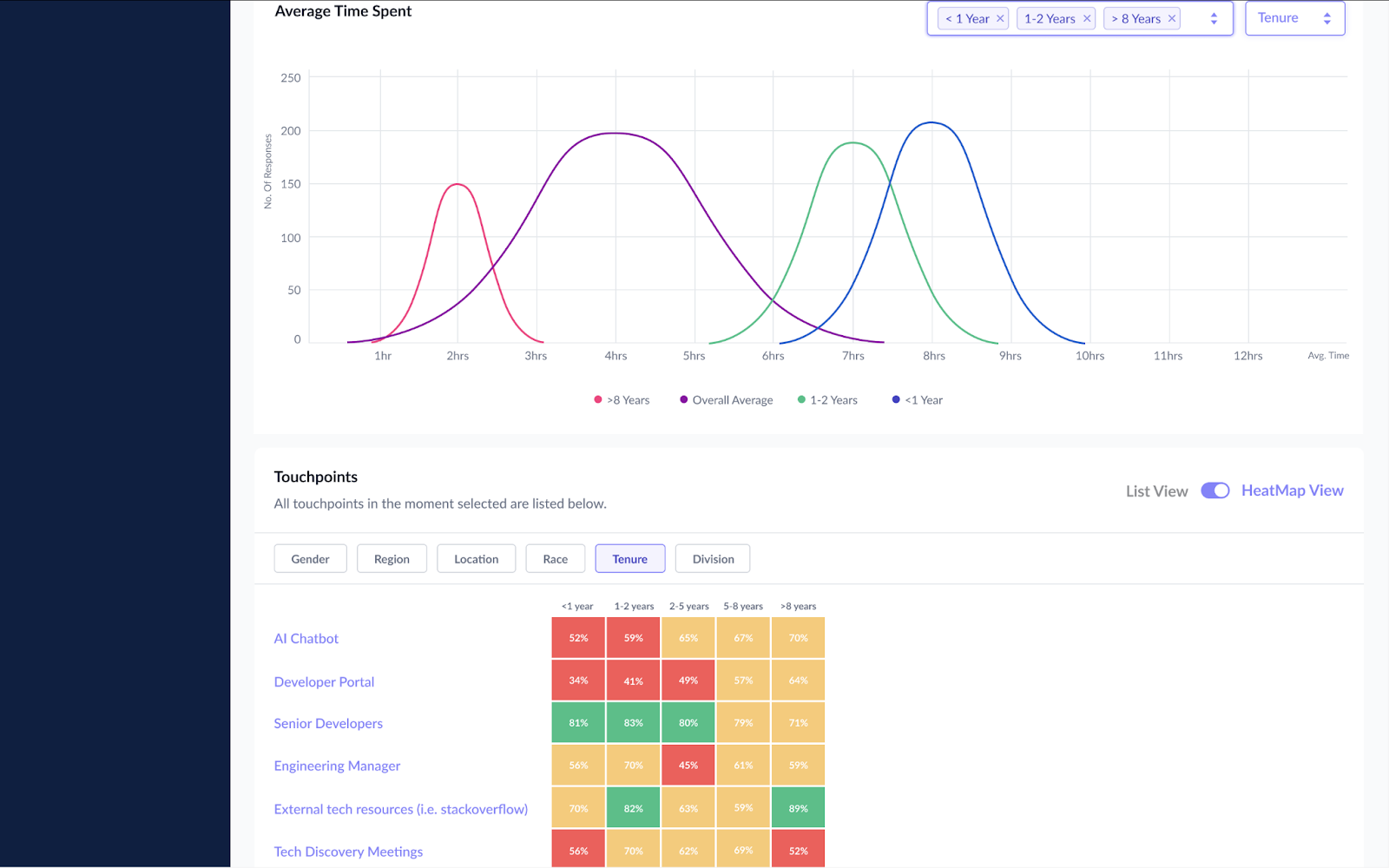
For each of your AI tools, you will get a full picture of its performance and satisfaction across multiple workflow activities. For instance, if we look at the AI code assistant that the organization implemented, across 5 different activities, we identify where the tool excels and where it falls short (Figure 3).

Dig into the user’s perspective to find out what is not working and how to fix it
Look at qualitative data:. Quantitative survey data will show you which work moments need to be improved to deliver a positive ROI. If you’re not sure how to improve the status quo, you can turn to qualitative data, which we gather in the form of open-ended survey questions. You can use our AI-powered analysis to dive into specific comments and discover what are the precise issues and how to fix them(Figure 4). These free text comments provide direct context about the specific task at hand, unlike standard survey tools.

How to Turn Your AI Projects ROI-Positive
Use the combination of quantitative and qualitative data to take a targeted action. After making a change, it’s important to re-survey your workers to see if the change resulted in the desired productivity outcome. Our platform is able to show how much time and money companies can save by removing friction in key daily activities of their employees and ultimately ensure that their AI investments are paying off by quantifying the impact on productivity (Figure 5).

AI Transformation Success Starts with Measuring the Right Things
AI’s potential to transform businesses is significant: the organizations currently leading in AI transformations are aiming for more than $1 billion in revenue increases from productivity savings.
If your organization is among the 96 percent that hasn’t yet cracked the code on turning AI technology into real business value, now is a great time to start measuring leading indicators of your AI tools’ success. And if you haven’t yet adopted any AI tools, now is an excellent time to assess work friction to see where AI could have the biggest impact in your organization.
When you’re ready to discuss your next steps, don’t hesitate to reach out.
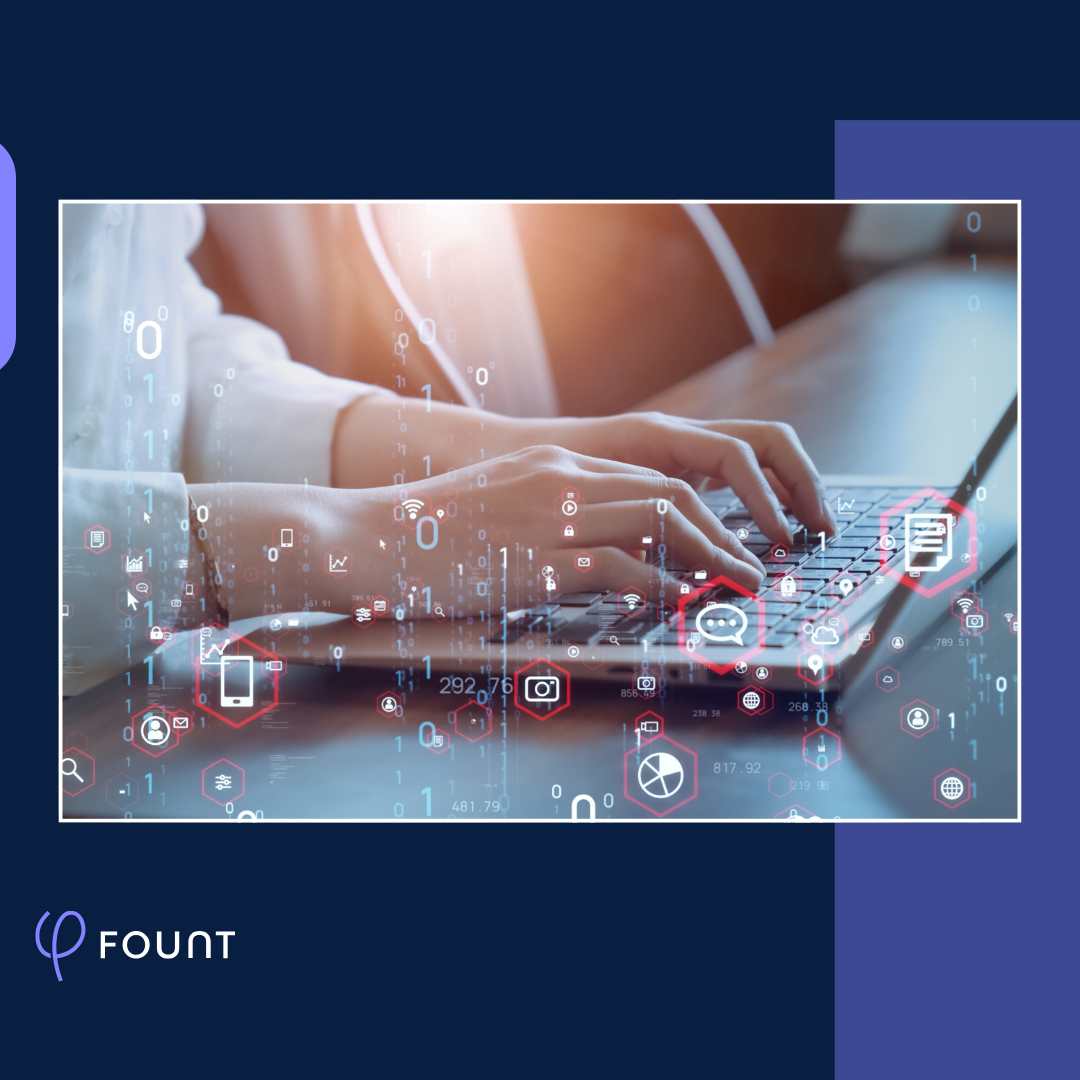
Trying to Embrace AI Tools? Don’t Forget to Listen to the Voice of the Worker
Amid much industry excitement and great enthusiasm from your board of directors, you unveil a promising new AI solution for your software development team that’s primed to jump-start productivity and boost revenue. But the rollout turns out to be a bit of a dud. It turns out your development team doesn’t like the tool, so they don’t really use it – and just like that, the project loses steam, ROI looks like a lost cause, and you’re back to square one.
Sound familiar? Some version of this scenario has been a reality for many organizations that have come up short in attempting to introduce new AI solutions to streamline processes or improve productivity. But how did it all go wrong? Why didn’t AI live up to its lofty billing? The answer might have been right in front of them all along.
Even as most AI projects aim to have a direct (and sometimes dramatic) impact on employees, those very employees are generally not consulted before AI tools and solutions are rolled out. But seeking out and incorporating feedback directly from the employees impacted by generative AI tools – that is, listening to the “worker’s voice” – can greatly improve the outcomes and ROI of AI transformations.
Focus on People, Not Technology
In many organizations, the pressure to implement AI solutions can lead to rushing into technology without considering the impact on people and processes. While scrutinizing a generative AI tool on a technical level should unquestionably be a key part of a company’s due diligence, failure to do likewise on a human level can be a project’s undoing.
AI solutions tend to unfold as bottom-up implementations, which means it will be nearly impossible to judge the relative success or failure of a particular tool if employees don’t use it. And employees won’t use a tool that doesn’t make their lives easier.
In other words, an AI project can fail without ever getting a real chance to demonstrate its merits. Maybe the tool you’ve chosen can improve productivity and drive remarkable ROI in your organization. But if your employees don’t see its value and therefore never really adopt it into their day-to-day routines, that potential becomes something of a moot point.
The Employee Voice Is an Essential Input
The good news in all of this is that AI projects are well-suited to experimentation, which means you don’t just have to roll out a tool once and hope for the best. Instead, you will likely have to try different approaches or variations on a solution to see what works. And as you cycle through these experiments, one of your key inputs should be employee feedback, which can help guide you through the modifications needed to get to a solution that works.
And make no mistake about it – employees will let you know their pain points if you listen to them. But to get them more solidly on board with your AI plans, it’s important to include them as an integral part of the process from the very start.
The goal is to get a better understanding of the areas where employees are experiencing work friction, which is the energy it takes for them to overcome any obstacle that gets in the way of doing their job, accomplishing a goal, or having their needs met. Once you know the sources of employees’ work friction, you can fashion your AI plans to address those specific pain points and then observe how your experiments ease (or fail to ease) those burdens.
Discerning the Employee Voice
Let’s say you’re looking to streamline the workflow of your software development team with an AI solution that helps them write technical documentation. On the surface, this looks like a great way to increase the team’s productivity. But how much do you actually know about what this specific task involves or whether the tool you’re considering will actually address the issues that bog them down?
Just as you wouldn’t approach any other aspect of a major project without solid numbers, incorporating employee voice into your AI implementation should likewise be based on meaningful data. The technical aspects of the project, for example, are too important to leave to guesswork. Likewise, the voice of the employee needs to be based on something more than simple assumptions about what they might be thinking or experiencing.
Finding areas of work friction is the most effective way to determine which AI solutions to try. By tailoring your AI experiments to target specific pain points, you’ll exponentially increase the likelihood that employees will give your proposed AI solution a try – and provide usable feedback on whether it helps to make their lives easier. From there, you’ll be able to get a much better handle on other productivity metrics, as well as ROI.
Make the Worker Voice a Key Component of Your AI Strategy
How many AI projects have failed because organizations went in with an ill-defined sense of the problem to be solved? How many stalled out because the technology was implemented without any clear connection to the issues that were actually causing employees problems or slowing down their work? How many were abandoned because low adoption made it impossible to accurately measure results? The common denominator in all of these negative outcomes is a lack of employee participation.
After-the-fact employee feedback is an important piece of any AI project implementation. But you shouldn’t wait until your project is that far down the road to bring employees into the process. By measuring work friction and incorporating the voice of the employee from the very outset, you’ll find it easier to both define the problem you’re trying to solve and experiment with AI solutions that directly address employee needs. And in the end, you’ll greatly increase your chances of employee uptake and, therefore, project success.
Ready to get a better sense of the voice of your employees? We can help!
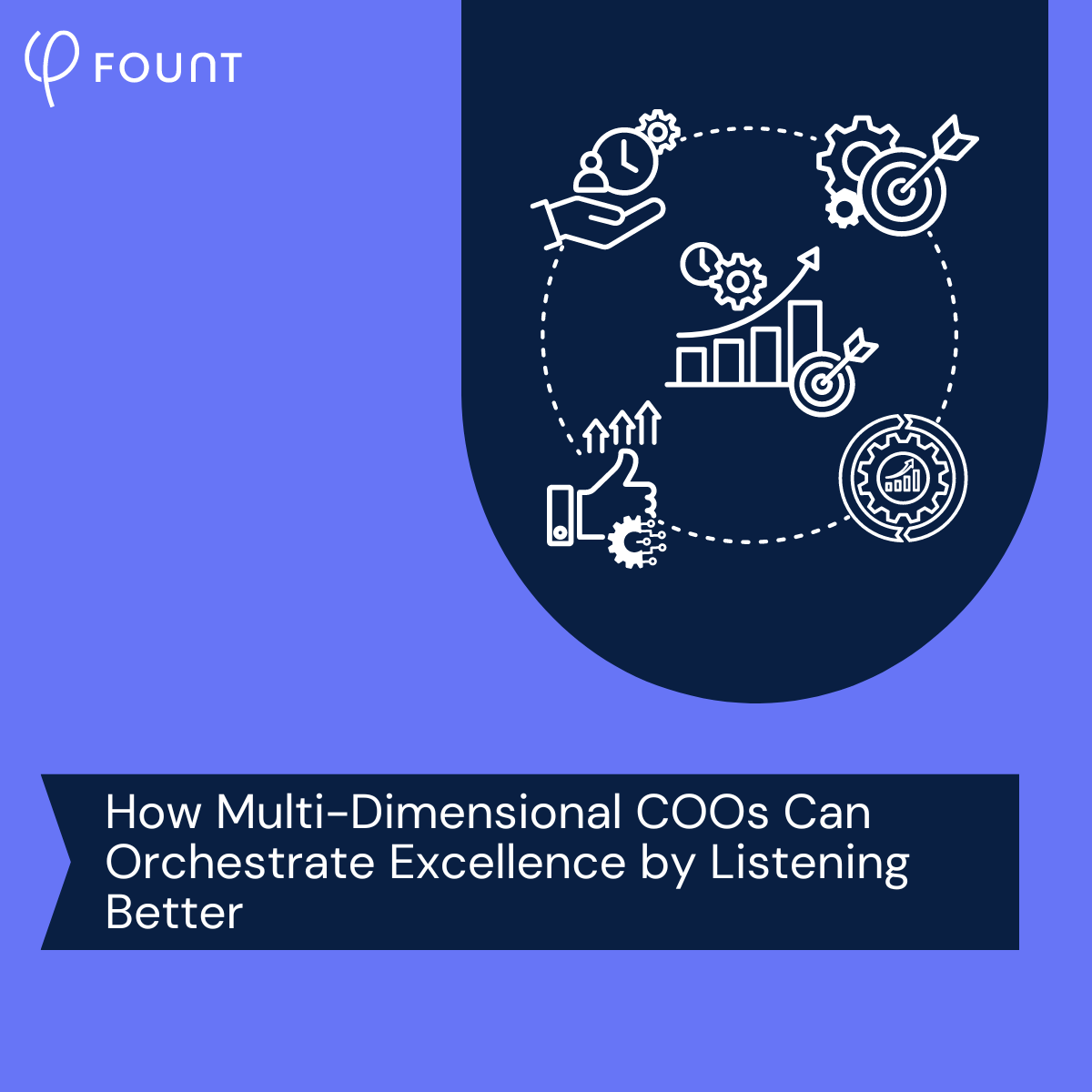
How Multi-Dimensional COOs Can Orchestrate Excellence by Listening Better
In a recent article for CEO Forum magazine, Assurant COO Francesca Luthi made the case that today’s COO’s have a complex, multi-dimensional mandate that includes driving digital transformation, cultural engagement, and improved customer and employee experiences, all while maintaining operational excellence and hitting growth targets.
The piece emphasizes that the COO role is complex in part because COOs are responsible for technology, talent, and transformation – that is, because “operations” includes virtually every aspect of an organization.
What we really like about it is Luthi’s inclusion of employee experience as a key component of overall operational excellence. Often, organizations emphasize customer experience but ignore or gloss over that of employees – a huge oversight, as far as we’re concerned. After all, organizational productivity is directly tied to individual effectiveness. And individual effectiveness is a function of overall employee experience.
In this piece, we’ll explain how multi-dimensional COOs can support organizational excellence by incorporating strategic, analytics-powered listening practices.
“What You Should Do” vs. “What Should I Do?”
In many organizations, COOs are tasked with improving organizational productivity. To achieve that, many assume the role of superior, telling employees what they should do: to be more productive, we’re going to use this new software. Or: to increase productivity, everyone will get certified in X skill.
This approach assumes that the leader knows what will work for every employee and that policy and process decisions should come from the top down.
Progressive leaders take a markedly different approach. Instead of mandating what their employees should do, they ask employees what they as leaders can do to help boost productivity.
Instead of assuming the leader has some special knowledge, this approach acknowledges the reality that workers in any given role are the ones with the most visibility into their daily tasks – and therefore into the barriers preventing them from doing those tasks efficiently. Put differently, this approach recognizes that workers are the ones best equipped to highlight sources of work friction.
Once you hear it, it sounds intuitive, right? Ask employees what’s not working, then fix those things and individual effectiveness and organizational productivity improve. But in practice, of course, that’s not easy to do. COOs can’t realistically ask thousands of employees what’s blocking them and then fix every single thing that comes up.
So let’s take a look at how to implement this strategy across a large, complex organization.
Analyzing Answer Data to Create Actionable Steps
When COOs listen to what their employees need and then address those needs, it improves productivity – but it also demonstrates that the COO cares about their workers. FOUNT offers a systematic way to demonstrate that care.
Our system starts with talking to leadership to get a sense of the problem they’re trying to solve. When we have a problem statement (“increase productivity,” “reduce input waste,” “use less energy,” etc.), we then examine the organizational structure to understand who does what.
From there, we conduct brief surveys with targeted employees. We take their answers and, using proprietary algorithms fueled by more than seven million data points about work friction, we identify solutions and rank them by potential impact.
Leaders walk away with not only objective data about where the biggest problems exist for their teams but also a data-backed guide to prioritizing solutions based on their expected ROI.
A Scalable Way to Address Inefficiencies
To understand why this approach to complex organizational problems works so well, it helps to contrast it to the default approach in many organizations. In addition to being top-down, the solutions behind many digital transformations tend to be additive: additional software, new processes, extra meetings.
This tendency is so common, in fact, there’s a name for it: addition sickness. If your organization is guilty of forever adding new things, don’t beat yourself up: when we’re presented with problems, we as a species are wired to think first of solutions that involve adding new things.
In many cases, though, problems can be solved by eliminating rather than adding.
When you approach problems from the ground floor, by asking the people most directly involved with those problems what’s causing them, you flip the script on the traditional approach. You also open yourself to solutions you may not have otherwise considered.
The impact on both productivity and ROI can be significant. When every employee is empowered to be more effective, the organization as a whole becomes more productive. And when you’re confident that you’re enacting the most impactful changes, you reach your expected ROI more quickly.
Organizational Excellence Can’t Ignore Employees
As the COO becomes responsible for ever more facets of an organization, prioritizing employee experience becomes essential: digital transformation can’t happen if employees aren’t willing to embrace new products; cultural engagement won’t happen if employees don’t feel that their insights and opinions matter; customers won’t have good experiences if they’re engaging with distressed front-line workers or using products built by an ever-rotating cast of back-end developers; growth targets are impossible to reach unless every employee can perform at the top of their ability.
In other words, employees are an essential component of organizational excellence. COOs who recognize that and find ways to not only gather data on employee experience but also turn that data into actionable insights to move the organization forward will be the ones with the greatest success in their complex, multi-dimensional roles.
Ready to start listening to your employees systematically? Get in touch. We’d love to help you take the next step.

You Just Deployed a New AI Tool. How Soon Can You Know if It’s Working?
You’ve deployed a new AI tool in your organization.
Congratulations!
Now the pressure’s off, right?
Wrong.
The pressure has simply shifted from the whirlwind of implementation to the expectation of tangible results. Whether the goal was to boost productivity, increase efficiency, or reduce costs, your AI investment is on the clock.
And that clock is ticking. While it typically takes a year or longer to see the intended impact of an AI investment, half of CFOs will cut funding for an AI project within that first 12 months if they’re not seeing positive ROI. In other words, if things aren’t working early, you may not get a chance to fix them before the plug gets pulled. That’s pressure.
Wouldn’t it be great if AI projects came with some kind of early warning system? In this piece, we’ll explain how having the right data can give you timely insight into what’s working, what’s not, and, most importantly, what you can do to course-correct a flagging AI project before it’s too late.
Is Your AI Pulling Its Weight?
You invested in AI to solve some problem in your organization. Maybe you had a software development team that was getting bogged down in rote tasks. Or a call center that was too overloaded with simple requests to quickly respond to customers who had more complex issues.
So you deployed AI to relieve some of the stress on your employees and thereby increase their productivity and efficiency. For the development team, an AI tool is now checking software specs to give your developers more time to create new code. And in the call center, an AI chatbot is handling some of the more routine calls, freeing up employees to deal with callers who have more complex issues.
Both of these sound like great AI use cases. But are they actually working for your employees and your organization? Are your developers writing more code thanks to the extra time the AI tool is affording them? Are your call center agents helping more customers or really cutting into those hold times because of AI? Are you seeing the ROI you expected?
AI Success Is Dependent on Your Employees
The answer to all of these questions lies in something called work friction – those moments of difficulty or struggle that employees are dealing with in their day-to-day work.
If the developers in the above scenario find, for example, that they can’t rely on the specs the AI tool is giving them, they won’t use it. The AI in this case not only hasn’t made their work easier, it’s forced them to go back and double-check information for accuracy – it’s actually created more friction.
Likewise, if customers are having issues with the call center AI chatbot, they’re likely going to call back and wait to speak to a human being. Now those employees will not only be fielding the calls that AI was supposed to cover, but they’ll be dealing with callers who are upset from that bad previous experience. Here too, they’re dealing with even more friction.
In both cases, if the employees have a choice, they’ll likely disable the AI agent or cut it out of their workflow.
Measure AI Effectiveness Using Worker Data
AI is user-dependent technology. If employees don’t see AI helping in specific areas where they’re encountering work friction, they won’t adopt the tool and you won’t see the results you’re hoping for. This is actually how many AI failures unfold – it’s not that the technology wasn’t good, but it wasn’t a good fit for employees in the specific use case it was supposed to help.
That’s why work friction is a key leading indicator of AI effectiveness. By getting to the heart of where your employees are experiencing friction, you can gauge whether the tool you’ve deployed is helping to ease their burden. Is your AI solution addressing the specific touchpoints or processes that are slowing down your employees? Is it making their work easier? Is it freeing them from routine tasks to focus on higher-value work?
If the answer to any of these questions is yes, you’ll likely see the productivity gains you expected from AI. If not, work friction analysis can provide valuable data you can use to adjust your deployment and try again.
For example, we recently worked with a financial services firm that rolled out AI for its development team with a goal very much like the situation described above. But the company didn’t have a clear idea of how the tool was going to impact the developers’ biggest problem areas. Perhaps unsurprisingly, those employees found it didn’t help much, so they stopped using it. The company had a failed AI investment on its hands.
With a detailed work friction analysis, however, the firm was able to see that developers were running into issues reviewing pull requests, finding answers about the code base, and writing technical documentation.
Now the company had a roadmap for adjusting the tool based on user feedback and redeploying it. When the firm implemented a GitHub Copilot to help with documentation and code review, the development team embraced it, which reduced their work friction.
And the company tallied $5.4 million in annual savings.
The Pressure Is on For AI to Deliver – Make Sure You Meet the Moment
The AI revolution forges ahead. A recent Wharton study found that while only 37 percent of large firms used AI weekly in 2023, 72 percent did in 2024. And the momentum doesn’t seem likely to slow in 2025.
Yet even as the pressure to deploy AI continues apace, the greater onus on leaders now will be to show the results of those investments. That can take time, of course, but one way to get an early idea of just how well (or how poorly) an AI experiment is going is to see how your employees are reacting to it.
Work friction data can be that leading indicator. Get in touch to find out how we can help provide the insight on whether your AI investment is headed for success – and, if it’s not, what you can do to fix it before it’s too late.
.svg)
Don't miss our latest content
Subscribe to our monthly newsletter


De-risk and Accelerate
Enterprise Transformations
FOUNT identifies the friction in your processes and technologies that slows down employee performance and transformation.
.svg)
Sign Up for Newsletter
Sign Up for
Newsletter
Monthly news and updates
By submitting this form, you confirm that you agree to the storing and processing of your personal data by FOUNT Global as described in our
Privacy Note
.svg)